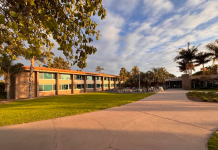Liat Shiloah
Contributing Writer
Names have been changed for anonymity.
The COVID-19 pandemic has strained healthcare resources across the country, and the Isla Vista Neighborhood Clinic (IVNC) is no exception. For most members of the Isla Vista community, the IVNC is their primary source of healthcare — but because of pandemic-related disruptions, routine healthcare has taken a backseat to COVID-related care.
According to Dr. Charles Fenzi, the CEO/CMO of the Santa Barbara Neighborhood Clinics (SBNC) — parent company of the IVNC — unemployment has also contributed to approximately 1,400 new Medi-Cal patients, California’s publicly-available health insurance, in all of the SBN Clinics. I spoke with providers at the IVNC to try and understand how they have been affected by the pandemic and identified three main issues: preventive care, behavioral health, and treatment for substance abuse.
Preventive care, or routine healthcare, is what we typically think of when we visit the doctor — things like annual checkups, birth control access, or routine vaccinations for children. As practitioner Zamfir, a healthcare professional associated with the clinic put it, “For things that hurt, people will still come in,” but in the current climate, will neglect routine visits. Dr. Fenzi describes the phenomenon as “deferred maintenance.”
Many patients are already less likely to come in for routine care, and this trend has been worsened due to fear of COVID-19. Resources previously allocated to preventive care have also been shifted to prioritize COVID-19 treatment. This has had significant impacts particularly on children, who are not receiving routine vaccinations, and on patients suffering from conditions that require close monitoring such as diabetes or high blood pressure.
“Many patients are already less likely to come in for routine care, and this trend has been worsened due to fear of COVID-19.”
However, new telehealth services (healthcare distributed through electronic communications) have increased access for some patients who previously would have to take essential time off work in order to visit the clinic but can now meet with their clinicians during breaks.
The IVNC also provides behavioral health services that have been greatly impacted by the pandemic. Isolation, grief, rising unemployment, and the fear of COVID-19 have all combined to worsen mental health for the previously non-anxious.
Practitioner Doe, a healthcare professional associated with the clinic, explained the “perfect storm,” where symptoms of a panic attack like chest pains, headaches, dizziness, and shortness of breath closely resemble COVID-19, which, in turn, cause further panic. As estimated by Doe, the clinic went from seeing 4-5 people a day for behavioral health services, to 6-10 over the course of the pandemic.
Doe explained that the effects of the pandemic on mental health are not identical. For students, the emptying of Isla Vista (I.V.) forced some back into their unsafe home lives and with the government shutdowns, they were left unable to escape potentially abusive homes. However, some patients have adjusted well to the conditions of the pandemic. Doe explained that “the window of acceptable behavior shifted,” and patients suffering from anxiety who struggled to leave their homes became “heroes of the pandemic.”
Another large part of what the IVNC does is substance abuse treatment — especially for opioid use disorder. Zamfir noted an approximate 40 percent increase in patients seeking treatment for substance abuse, and both Zamfir and Fenzi cited increases in overdoses. This is partly due to the aforementioned pandemic conditions that worsen mental health and an increase in the presence of fentanyl — a potent synthetic opioid present in more commonly abused street drugs such as heroin, benzodiazepines, cocaine, and MDMA.
“The IVNC sees many patients from outside I.V. and even outside Santa Barbara County for substance abuse treatment, who now are able to see their practitioners and gain access to the potentially life-saving medication without needing to travel to the clinic.”
Fentanyl is known in the medical community for being particularly difficult to transition off, as it remains in one’s system far longer than other commonly used opiates. The IVNC specializes in medically-assisted treatment with the use of Suboxone — a mild opiate that helps mitigate withdrawal symptoms. Suboxone can be a risky medication and requires frequent patient visits in order to regulate its use.
In this sense, telehealth has provided a silver lining. The IVNC sees many patients from outside I.V. and even outside Santa Barbara County for substance abuse treatment, who now are able to see their practitioners and gain access to the potentially life-saving medication without needing to travel to the clinic.
The IVNC provides necessary healthcare to members of our community who might otherwise not have access. It’s an open secret that the United States has rampant healthcare inequity, and providers like those at the Santa Barbara Neighborhood Clinics are doing the admirable work of trying to bridge the gap. For all that, they are not immune to the conditions of the pandemic and while advances in telehealth have helped in some regards, other people are still being left behind.
If you or someone you know is struggling with mental health, an unsafe home life, or substance abuse — reach out.
SAMHSA Hotline (Substance Abuse/Mental Health): 1-800-662-HELP (4357)
National Suicide Prevention Hotline: 1-800-273-TALK (8255)
National Domestic Violence Hotline: 1-800-799-SAFE (7233)
UCSB CAPS (Counseling and Psychological Services): 1-805-893-4411











